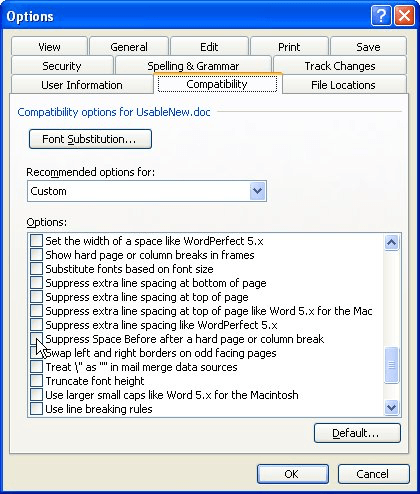Please Note: This article is written for users of the following Microsoft Word versions: 97, 2000, 2002, and 2003. If you are using a later version (Word 2007 or later), this tip may not work for you. For a version of this tip written specifically for later versions of Word, click here: Getting the Expected Space Before a Heading.
If you take advantage of styles in your Word documents, they can make your formatting much more consistent and easier than formatting manually. You can define styles for all sorts of elements in your documents.
One of the most common document elements to format is different heading levels. When formatting headings, it is not unusual to set them off from surrounding text by adding additional space before them. Word lets you do this in the style definition for the heading. You can specify virtually any amount of additional space before the heading that you want.
When your heading style includes additional space before the paragraph, you may be surprised when Word sometimes fails to add that expected space. For instance, when the heading appears right after a page break or a column break, Word normally doesn't include that extra space. Instead, the heading appears right up at the top of the page or column.
Truth be told, the only place that Word will honor your specification for extra space is if the heading is the first paragraph in the document, if it appears within the body of the text on a page, or if it appears right after a section break.
How Word handles the "space before" setting for paragraphs (including headings) when those paragraphs appear after a page break or a column break is actually a configurable setting in Word. Follow these steps to make adjustments to your system:

Figure 1. The Compatibility tab of the Options dialog box.
You should note that if your heading style specifies space before the heading, and that heading naturally falls at the top of a page, Word suppresses that extra space, no matter what. The reason is because Word "eats up" the extra space, as if it was really at the bottom of the previous page.
WordTips is your source for cost-effective Microsoft Word training. (Microsoft Word is the most popular word processing software in the world.) This tip (68) applies to Microsoft Word 97, 2000, 2002, and 2003. You can find a version of this tip for the ribbon interface of Word (Word 2007 and later) here: Getting the Expected Space Before a Heading.

Learning Made Easy! Quickly teach yourself how to format, publish, and share your content using Word 2021 or Microsoft 365. With Step by Step, you set the pace, building and practicing the skills you need, just when you need them! Check out Microsoft Word Step by Step today!
Styles are a great boon for applying styles in a powerfully consistent manner. How Word applies styles, however, depends ...
Discover MoreWant to get your text away from the explicit formatting you applied, back to the underlying formatting? Here are a couple ...
Discover MoreIt is frustrating to spend a lot of time working on a document, getting your styles just right, and then have those ...
Discover MoreFREE SERVICE: Get tips like this every week in WordTips, a free productivity newsletter. Enter your address and click "Subscribe."
There are currently no comments for this tip. (Be the first to leave your comment—just use the simple form above!)
Got a version of Word that uses the menu interface (Word 97, Word 2000, Word 2002, or Word 2003)? This site is for you! If you use a later version of Word, visit our WordTips site focusing on the ribbon interface.
Visit the WordTips channel on YouTube
FREE SERVICE: Get tips like this every week in WordTips, a free productivity newsletter. Enter your address and click "Subscribe."
Copyright © 2026 Sharon Parq Associates, Inc.
Comments